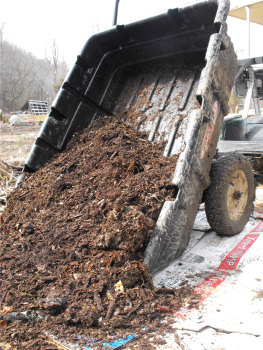
Lignin makes plants difficult to decompose
 You
may have heard that putting fresh wood chips on your garden is a bad
idea. Wood contains lots of lignin, which binds to nitrogen and
won't let it go for months or years. When soil microorganisms
begin decomposing the wood chips, there isn't any nitrogen for them to
eat, so they have to take nitrogen out of the soil. The result is
that plants whose roots are in the soil under fresh wood chips can't
get any nitrogen and they struggle to grow. After a while, the
wood chips break down to the point that they release nitrogen rather
than hogging it --- then your plants get happy.
You
may have heard that putting fresh wood chips on your garden is a bad
idea. Wood contains lots of lignin, which binds to nitrogen and
won't let it go for months or years. When soil microorganisms
begin decomposing the wood chips, there isn't any nitrogen for them to
eat, so they have to take nitrogen out of the soil. The result is
that plants whose roots are in the soil under fresh wood chips can't
get any nitrogen and they struggle to grow. After a while, the
wood chips break down to the point that they release nitrogen rather
than hogging it --- then your plants get happy.
Although leaves contain much less lignin than wood, the same effect can
occur. Leaves
that contain more than 15% lignin are difficult to decompose.
Although
I couldn't find a comprehensive list of the percent lignin in all the
tree
species in my woods, I think I can use a pretty simple rule of thumb
--- if leaves feel thin and melt into the ground within a couple of
months, they clearly have low lignin levels. Trees like oaks,
beech,
and sycamore with thick leaves that stick around for a long time have
high lignin levels and might leach nitrogen out of my soil before
giving any back.
I'll have to wait to see the results of my winter leaf mulching, but I
suspect that the thin leaves I've put on my garden beds will melt in by
spring and enrich the soil. The thicker leaves may need to be
raked back or supplemented by urine and manure. Next year, I'll
be more prepared and will use oak, beech, and sycamore leaves as mulch
over manure in my perennial plantings while reserving leaves from
maples and tulip-trees for my vegetable garden.
Mafongoya, P.L., K.E. Giller, and C.A. Palm. 1998.
Decomposition and nitrogen release patterns of tree prunings and
litter. Agroforestry Systems.
38: 77-97.
| This post is part of our Leaves for Fertility lunchtime series.
Read all of the entries: |
Want more in-depth information? Browse through our books.
Or explore more posts by date or by subject.
About us: Anna Hess and Mark Hamilton spent over a decade living self-sufficiently in the mountains of Virginia before moving north to start over from scratch in the foothills of Ohio. They've experimented with permaculture, no-till gardening, trailersteading, home-based microbusinesses and much more, writing about their adventures in both blogs and books.
Want to be notified when new comments are posted on this page? Click on the RSS button after you add a comment to subscribe to the comment feed, or simply check the box beside "email replies to me" while writing your comment.
